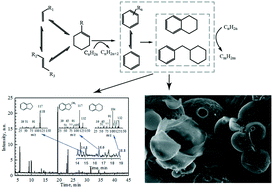当前位置:
X-MOL 学术
›
Catal. Sci. Technol.
›
论文详情
Our official English website, www.x-mol.net, welcomes your
feedback! (Note: you will need to create a separate account there.)
Conversion and coking of olefins on SAPO-34
Catalysis Science & Technology ( IF 4.4 ) Pub Date : 2017-10-23 00:00:00 , DOI: 10.1039/c7cy01898c Bing Hu 1, 2, 3, 4, 5 , Guoliang Mao 1, 2, 3, 4, 5 , Dakang Wang 1, 2, 3, 4, 5 , Yadong Fu 1, 2, 3, 4, 5 , Baohui Wang 1, 2, 3, 4, 5 , Mingjian Luo 1, 2, 3, 4, 5
Catalysis Science & Technology ( IF 4.4 ) Pub Date : 2017-10-23 00:00:00 , DOI: 10.1039/c7cy01898c Bing Hu 1, 2, 3, 4, 5 , Guoliang Mao 1, 2, 3, 4, 5 , Dakang Wang 1, 2, 3, 4, 5 , Yadong Fu 1, 2, 3, 4, 5 , Baohui Wang 1, 2, 3, 4, 5 , Mingjian Luo 1, 2, 3, 4, 5
Affiliation

|
Conversion and coking of ethene, propene, 1-butene and their mixtures on SAPO-34 are investigated on a fixed bed reactor. Results indicate that 1-butene maintains a high conversion (ca. 97%), conversion of propene decreases from 64% to 28%, and ethene shows a very low conversion (ca. 14%). However, the conversion of ethene is improved by externally added or in situ formed propene and butene. This difference in olefin conversion is mainly related to the carbocationization tendency of olefins. The coking is also associated with the reactivity of olefins; moreover, the coking is related to the synergy effect between the diffusivity of olefins and the volumetric restriction of cages. Coke derived from the least diffusible 1-butene tends to have single and double ring structures. Coke derived from propene tends to form two or three fused ring structures. In addition, the most diffusible ethene favors the formation of three- or four-ring aromatics in SAPO-34 cages. Moreover, due to the alkylation across cage windows, well-bridged reticulate structure coke is formed in the SAPO-34 crystal. The effects of the olefins' further reaction on the MTO process are also discussed. It is supposed that the olefins' further reaction is one of the main sources of the coking. To design good performance MTO catalysts and to reveal the MTO mechanism, more attention should be paid to the effects of the olefins' further reactions.
中文翻译:

在SAPO-34上烯烃的转化和焦化
在固定床反应器上研究了乙烯,丙烯,1-丁烯及其混合物在SAPO-34上的转化和焦化。结果表明,1-丁烯保持较高的转化率(约97%),丙烯的转化率从64%降低至28%,乙烯显示出非常低的转化率(约14%)。但是,通过外部添加或原位提高乙烯的转化率形成丙烯和丁烯。烯烃转化率的这种差异主要与烯烃的碳阳离子化趋势有关。焦化也与烯烃的反应性有关。此外,焦化与烯烃的扩散率和笼的体积限制之间的协同作用有关。衍生自最小扩散性的1-丁烯的焦炭倾向于具有单环和双环结构。源自丙烯的焦炭倾向于形成两个或三个稠合的环结构。此外,最易扩散的乙烯有利于在SAPO-34笼中形成三环或四环芳烃。此外,由于笼窗上的烷基化,在SAPO-34晶体中形成了桥联良好的网状结构焦炭。还讨论了烯烃进一步反应对MTO工艺的影响。据推测,烯烃 进一步的反应是焦化的主要来源之一。为了设计出性能良好的MTO催化剂并揭示MTO机理,应更加注意烯烃进一步反应的影响。
更新日期:2017-11-08
中文翻译:

在SAPO-34上烯烃的转化和焦化
在固定床反应器上研究了乙烯,丙烯,1-丁烯及其混合物在SAPO-34上的转化和焦化。结果表明,1-丁烯保持较高的转化率(约97%),丙烯的转化率从64%降低至28%,乙烯显示出非常低的转化率(约14%)。但是,通过外部添加或原位提高乙烯的转化率形成丙烯和丁烯。烯烃转化率的这种差异主要与烯烃的碳阳离子化趋势有关。焦化也与烯烃的反应性有关。此外,焦化与烯烃的扩散率和笼的体积限制之间的协同作用有关。衍生自最小扩散性的1-丁烯的焦炭倾向于具有单环和双环结构。源自丙烯的焦炭倾向于形成两个或三个稠合的环结构。此外,最易扩散的乙烯有利于在SAPO-34笼中形成三环或四环芳烃。此外,由于笼窗上的烷基化,在SAPO-34晶体中形成了桥联良好的网状结构焦炭。还讨论了烯烃进一步反应对MTO工艺的影响。据推测,烯烃 进一步的反应是焦化的主要来源之一。为了设计出性能良好的MTO催化剂并揭示MTO机理,应更加注意烯烃进一步反应的影响。











































 京公网安备 11010802027423号
京公网安备 11010802027423号